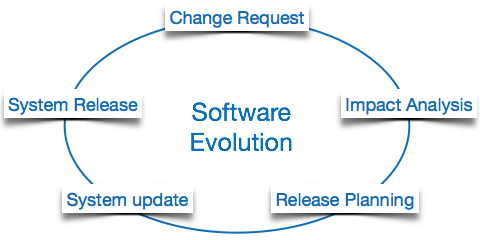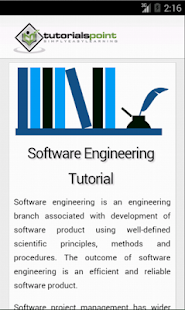Software Engineering Tutorialspoint
- Software Engineering Pdf Download
- Software Engineering Tutorial
- Software Engineering Layers Tutorialspoint
Software Engineering Tutorial delivers basic and advanced concepts of Software Engineering. Software Engineering Tutorial is designed to help beginners and professionals both. Software Engineering provides a standard procedure to design and develop a software. Computer software that meets the requirements of its client/user is complicated to create. Software Engineering gives a framework for software development that ensures quality. It is the application of a systematic and disciplined process to produce reliable and economical software. This tutorial is designed to explain various aspects of software development and different techniques used for building the system. This tutorial is a good introductory guide to the need and overall features of software engineering. This tutorial is designed to introduce Software Engineering concepts to the upcoming software professionals. This tutorial is designed to explain various aspects of software development and different techniques used for building the system. This tutorial is a good introductory guide to the need and overall features of software engineering. This tutorial is designed to introduce Software Engineering concepts to the upcoming software professionals. Software quality assurance (SQA) is a process that ensures that developed software meets and complies with defined or standardized quality specifications. SQA is an ongoing process within the software development life cycle (SDLC) that routinely checks the developed software to ensure it meets desired quality measures. Software Engineering Tutorial - Software engineering is an engineering branch associated with development of software product using well-defined scientific principles, methods and procedures. Software Quality Assurance (SQA) SQA is the planned and systematic pattern of activities which are required to give a guarantee of software quality. For example, during the software development meetings are conducted at every stage of development to find out the defects and suggest improvements to produce good quality software.
Have a look at pagalworld and find the hottest Bollywood mp3 music collection. Pagalworld delivers the popup, remixed, DJ, celebration and latest mp3 music set at free of charge. New mp3 song download zip file. Why Pagalworld:Wish to download free mp3 music? Also, it highlights how one may stream or download one's favourite pop tunes from reputed audio portals.
- Software Engineering Tutorial
- S/W - Exams Questions with Answers
- S/W Engineering Resources
- Selected Reading
Software design is a process to transform user requirements into some suitable form, which helps the programmer in software coding and implementation.
For assessing user requirements, an SRS (Software Requirement Specification) document is created whereas for coding and implementation, there is a need of more specific and detailed requirements in software terms. The output of this process can directly be used into implementation in programming languages.
Software design is the first step in SDLC (Software Design Life Cycle), which moves the concentration from problem domain to solution domain. It tries to specify how to fulfill the requirements mentioned in SRS.
Software Design Levels
Software design yields three levels of results:
Os x 10.9 download dmg. The most relevant program for Mac os x mavericks.dmg download is Mac OS X Mavericks 10.9. Get a free download for Operating systems software in the specialized download selection. Oct 22, 2013 Apple OS X download Mavericks was announced in June 2013 and was released in the month of October the same year. It was the 10th big release of Mac OS X line, after being rebranded in 2002 by Apple from its previous product line of Mac OS. At the time of release, Mavericks was marketed and promoted as a major release by Apple similar to how they marketed the Lion and Mountain Lion. May 28, 2018 About Mac OS Mavericks 10.9. Apple OS X Mavericks was first announced in June 2013 and was then released in October of 2013. It was the tenth big release of the Apple OS X line. At the same time, Mavericks was promoted and marketed as a major release just as was the case with the Lion and Mountain Lion OS X updates which came before the Mavericks. Sep 04, 2015 Mac OS X 10.9; This is a self made 10.9 mavericks full dmg. It only has osx 10.9 vanilla image. This can be use to make USB installer that will work on.
Software Engineering Pdf Download
- Architectural Design - The architectural design is the highest abstract version of the system. It identifies the software as a system with many components interacting with each other. At this level, the designers get the idea of proposed solution domain.
- High-level Design- The high-level design breaks the ‘single entity-multiple component’ concept of architectural design into less-abstracted view of sub-systems and modules and depicts their interaction with each other. High-level design focuses on how the system along with all of its components can be implemented in forms of modules. It recognizes modular structure of each sub-system and their relation and interaction among each other.
- Detailed Design- Detailed design deals with the implementation part of what is seen as a system and its sub-systems in the previous two designs. It is more detailed towards modules and their implementations. It defines logical structure of each module and their interfaces to communicate with other modules.
Modularization
Modularization is a technique to divide a software system into multiple discrete and independent modules, which are expected to be capable of carrying out task(s) independently. These modules may work as basic constructs for the entire software. Designers tend to design modules such that they can be executed and/or compiled separately and independently.
Modular design unintentionally follows the rules of ‘divide and conquer’ problem-solving strategy this is because there are many other benefits attached with the modular design of a software.
Advantage of modularization:
- Smaller components are easier to maintain
- Program can be divided based on functional aspects
- Desired level of abstraction can be brought in the program
- Components with high cohesion can be re-used again
- Concurrent execution can be made possible
- Desired from security aspect
Concurrency
Software Engineering Tutorial
Back in time, all software are meant to be executed sequentially. By sequential execution we mean that the coded instruction will be executed one after another implying only one portion of program being activated at any given time. Say, a software has multiple modules, then only one of all the modules can be found active at any time of execution.

In software design, concurrency is implemented by splitting the software into multiple independent units of execution, like modules and executing them in parallel. In other words, concurrency provides capability to the software to execute more than one part of code in parallel to each other.
It is necessary for the programmers and designers to recognize those modules, which can be made parallel execution.
Example
The spell check feature in word processor is a module of software, which runs along side the word processor itself.
Coupling and Cohesion
When a software program is modularized, its tasks are divided into several modules based on some characteristics. As we know, modules are set of instructions put together in order to achieve some tasks. They are though, considered as single entity but may refer to each other to work together. There are measures by which the quality of a design of modules and their interaction among them can be measured. These measures are called coupling and cohesion.
Cohesion
Cohesion is a measure that defines the degree of intra-dependability within elements of a module. The greater the cohesion, the better is the program design.
There are seven types of cohesion, namely –
- Co-incidental cohesion - It is unplanned and random cohesion, which might be the result of breaking the program into smaller modules for the sake of modularization. Because it is unplanned, it may serve confusion to the programmers and is generally not-accepted.
- Logical cohesion - When logically categorized elements are put together into a module, it is called logical cohesion.
- Temporal Cohesion - When elements of module are organized such that they are processed at a similar point in time, it is called temporal cohesion.
- Procedural cohesion - When elements of module are grouped together, which are executed sequentially in order to perform a task, it is called procedural cohesion.
- Communicational cohesion - When elements of module are grouped together, which are executed sequentially and work on same data (information), it is called communicational cohesion.
- Sequential cohesion - When elements of module are grouped because the output of one element serves as input to another and so on, it is called sequential cohesion.
- Functional cohesion - It is considered to be the highest degree of cohesion, and it is highly expected. Elements of module in functional cohesion are grouped because they all contribute to a single well-defined function. It can also be reused.
Coupling
Coupling is a measure that defines the level of inter-dependability among modules of a program. It tells at what level the modules interfere and interact with each other. The lower the coupling, the better the program.
There are five levels of coupling, namely -
- Content coupling - When a module can directly access or modify or refer to the content of another module, it is called content level coupling.
- Common coupling- When multiple modules have read and write access to some global data, it is called common or global coupling.
- Control coupling- Two modules are called control-coupled if one of them decides the function of the other module or changes its flow of execution.
- Stamp coupling- When multiple modules share common data structure and work on different part of it, it is called stamp coupling.
- Data coupling- Data coupling is when two modules interact with each other by means of passing data (as parameter). If a module passes data structure as parameter, then the receiving module should use all its components.
Ideally, no coupling is considered to be the best.
Design Verification

The output of software design process is design documentation, pseudo codes, detailed logic diagrams, process diagrams, and detailed description of all functional or non-functional requirements.
Software Engineering Layers Tutorialspoint
The next phase, which is the implementation of software, depends on all outputs mentioned above.
It is then becomes necessary to verify the output before proceeding to the next phase. The early any mistake is detected, the better it is or it might not be detected until testing of the product. If the outputs of design phase are in formal notation form, then their associated tools for verification should be used otherwise a thorough design review can be used for verification and validation.
By structured verification approach, reviewers can detect defects that might be caused by overlooking some conditions. A good design review is important for good software design, accuracy and quality.